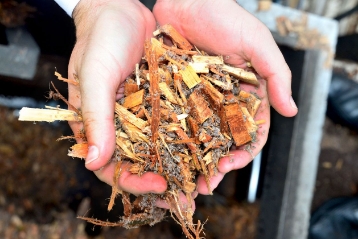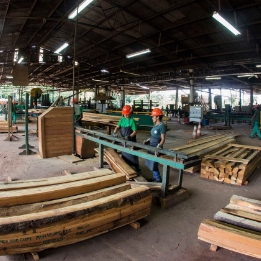Offsetting of CO2 emissions at Lufthansa Cargo
Climate protection projects by myclimate
Lufthansa Cargo is offsetting CO2 emissions by participating in a selection of ten climate protection projects curated by the Lufthansa Group, which were set up by the non-profit organization myclimate. Our partner only applies the strictest, independent quality standards, such as Gold Standard and Plan Vivo, when selecting and organizing climate protection projects.
CO2 offsetting is a useful additional measure for our company and complements other efforts to limit or prevent our own CO2 emissions from the outset. For example, we use lightweight loading equipment or innovative technologies to reduce direct CO2 emissions during a flight. Lufthansa Cargo also offers customers other sustainable aviation fuels to reduce CO2 emissions.


How does CO2 offsetting work?
CO2 offsetting refers to all measures taken by companies to offset their emissions through the financing of emissions reduction or prevention by way of special climate protection projects. Offsetting is a supplemental environmentally friendly measure, especially in sectors where the potential for emissions reduction is limited, as is the case with aviation at present.
CO2 offsetting is a means of compensating for CO2 emissions by way of various climate protection projects. It is irrelevant where the emissions are generated and where the offsetting takes place. What matters is that the two amounts are the same overall. The climate protection projects selected by us promote the use of renewable energies, realize energy-efficiency measures, and reduce methane emissions, to give just a few examples. All this can be done using state-of-the-art technology, by filtering greenhouse gases from power plants and production facilities, and through reforestation and other agricultural measures. Companies can offset a specific volume of CO2, such as the volume emitted during the transportation of their freight. They receive so-called emission reduction credits – also known as certificates – on the basis of the CO2 saved or captured during the various projects.
Another positive side effect of the projects selected by us is the benefits they bring to the local population and environment. The projects create jobs, optimize infrastructures, reduce health risks, protect biodiversity, and improve educational opportunities.
Examples of Lufthansa Cargo climate protection projects
We see CO2 offsetting as one of many ways to contribute to a company’s sustainability. The following examples show what we mean by this in relation to our curated climate protection projects.

Wood biomass instead of gas boilers in Brazil
This project reduces CO2 emissions by installing a biomass boiler instead of a gas boiler at a pulp and paper mill in Caieiras, Sao Paulo, Brazil, to supply steam to a new paper machine. The steam produced by the new biomass boiler is a vital part of any pulp and paper manufacturing process and is therefore essential for the mill to remain competitive.
The project promotes the use of ash as fertilizer in agriculture and forestry for the first time, and it gives value to biomass waste by using residue such as sludge from the mill’s own production process to generate energy. The mill produces 100,000 tonnes of paper items a year, such as hygiene products, tissues, and paper towels.
- Annual CO₂ reduction: approx. 49,000 tonnes
- Project standard: Gold Standard
- Detailed project description: https://de.myclimate.org/en/information/climate-protection-projects/detail-climate-protection-projects/brazil-biomass-7179/
Electricity from FSC wood waste in the Amazon
The project replaces several diesel generators and helps to supply the approximately 80,000 inhabitants of the city of Itacoatiara with climate-friendlier power. Thanks to the power plant, the local population benefits from lower energy prices and a more stable supply of energy. The plant generates up to 45,000 MWh of electricity a year, which would otherwise consume some 10-15 million liters of diesel. The waste heat generated is used for the wood drying plants.
Some 100,000 tonnes of wood are needed each year for the production of electricity, and this is provided in the form of wood waste and sawdust from the sawmill. All this wood waste comes from sustainable forestry in accordance with FSC guidelines. Prior to the start-up of the plant, this wood waste was rotting in large piles on the premises. The sustainable use of the waste has therefore reduced the emission of the greenhouse gas methane.
- Annual CO₂ reduction: approx. 47,000 tonnes
- Project standard: Gold Standard
- Detailed project description: https://www.myclimate.org/information/carbon-offset-projects/detail-carbon-offset-projects/brazil-biomass-7123/


Community reforestation in Nicaragua
This reforestation project in the Platanares watershed in the municipality of San Juan de Limay, Nicaragua, involves smallholder farming families working together to reforest unused parts of their land. Improving the use of the space and ensuring the sustainable use of forest resources will increase the forest area near the watershed, while improving the quality of life of Limay’s residents.
These aims will be achieved through the establishment of multiple small-scale native species forest plantations on smallholder land. The project involves three different types of plantation: Mixed species plantations composed of fast-growing firewood and longer-lived hardwood species; coffee agroforestry (shade-grown coffee and fruit trees); and silvopastoral planting on areas mainly used for cattle breeding.
- Annual CO₂ reduction: approx. 625,000 tonnes
- Project standard: Gold Standard
- Detailed project description: https://de.myclimate.org/en/information/climate-protection-projects/detail-climate-protection-projects/nicaragua-forestry-7186/
Efficient cook stoves save habitat for mountain gorillas in Rwanda
A reduction in the use of firewood means more habitat for animals, less deforestation, a reduction in greenhouse gases, more time, money, and improved health for women and girls in Rwanda. This can be achieved with the subsidized sale of energy-efficient cook stoves to families living near the Volcanoes National Park in northwest Rwanda. Together with the local population, a locally producible, efficient cook stove model was developed which uses two thirds less firewood than the conventional open three-stone fireplaces.
In addition to protecting the habitat of mountain gorillas and saving CO2, the project is also changing the lives of women and girls, who spend less time and money procuring firewood and are less exposed to harmful soot particles from the open fires thanks to the efficient burning of the new cook stoves.
- Annual CO₂ reduction: approx. 38,000 tonnes
- Project standard: Gold Standard
- Detailed project description:https://de.myclimate.org/en/information/climate-protection-projects/detail-climate-protection-projects/rwanda-efficient-cook-stoves-7213/


